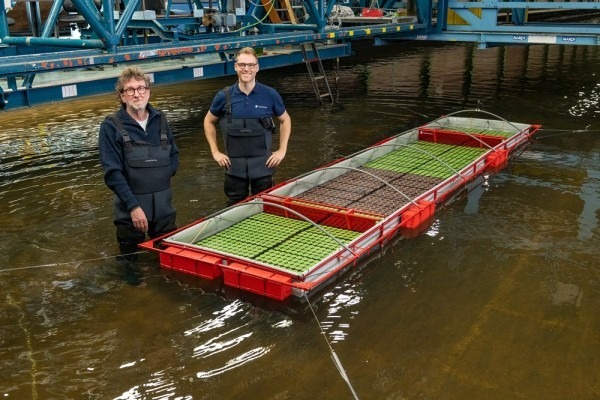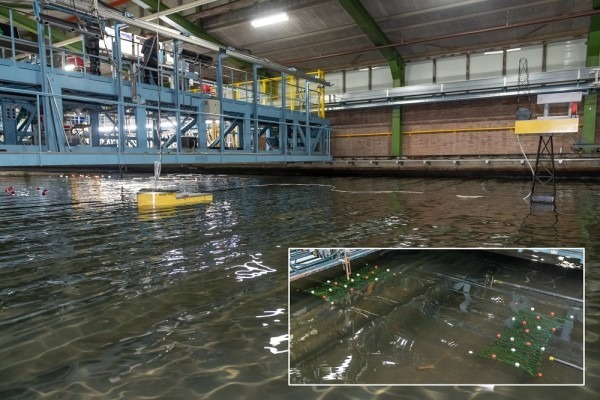Growing interest in floating food production
One of the UN’s Sustainable Development Goals pledges to “end hunger, achieve food security and improved nutrition and promote sustainable agriculture”. As the world population continues to climb, food production at sea is likely to become an increasingly important resource. Here we present two interesting research initiatives.
Growing crops on water
Each year MARIN offers a number of basin slots to innovative SMEs free of charge. One of the selected projects was the Floating Food Farm of Floating Future, which is a concept for carrying out food production on a flexible floating structure. Innovative, highly relevant and hydrodynamically very interesting! No wonder this pioneering concept was selected.
In the future there will be a shortage of agricultural land, while at the same time, the world population is increasing. The challenge is providing inhabitants of cities with fresh food in a sustainable way. Floating Future has found a possible solution for this by growing the crops on open water.
The islands for which a patent application was filed consist of a slender, flexible structure that enclose a body of fresh water, which is then separated from the open water. Smaller floaters with plants are placed on top of this fresh water. Nutrients are then supplemented to the fresh water so the roots of the plants get their nutrients directly, and there is no need for costly soil. This system – known as hydroponics – is already widely used in greenhouses in the Netherlands.
Model tests were executed at MARIN’s Shallow Water Basin at a scale of 1:5. The main objective was to study the behaviour of the floating flexible structure in waves, and specifically the interaction with the body of fresh water inside. Therefore, the elasticity of the model needed to be scaled correctly, a challenge the team was happy to tackle. The tests showed a promising result; the flexible structure moved with the waves and the fresh water didn’t spill, even when faced with the largest waves that are expected.
MARIN is looking forward to extending this collaboration and exploring the possible application of this innovation.
Seaweed at industrial scale
Seaweed is a sustainable and healthy source of food. All over the world you can find examples of seaweed cultivation. There are quite some diverse solutions, but what do they have in common? -that it is a very labour-intensive business, typically established at small production sites. But could there be a future for industrialisation?
Within the MARIN Blue Growth programme we have researched different aspects of seaweed production already. In this research the focus is on operations. Seaweed cultivation today is very labour intensive, with both seeding and harvesting done by hand from small vessels. Nevertheless, in order to be commercially viable this operation needs to be mechanised.
This MARIN open innovation project started off with a concept design workshop with industry experts from different backgrounds. Technical offshore partners, as well as researchers and developers from the seaweed sector, took part. The aim is to establish a farm able to produce year round, far offshore. This seems counterintuitive, as a nearshore farm is much easier logistically and in general the water is also richer in nutrients. It was deemed however, that nearshore, large-scale production would be too vulnerable for ‘undesired’ species that could threaten the harvest such as mussels or algae.
As the harvest is voluminous, shipping of the product is also uneconomical. Therefore the concept makes use of existing (gas) infrastructure with pipelines to the shore. Old gas platforms can even be used as a hub. A harvesting and processing module on board will pump the product to the hub via a floating hose in order to minimise transloading operations. The vessels will eventually be sailing autonomously, which is the ultimate goal.
From a hydrodynamical point of view, most questions arose around the floating hose. As the hose is hundreds of metres long, would it entangle in (mild) sea states? What is the qualitative drifting behaviour of such a hose? And just as important, would a small working boat have sufficient thrust too pull it? To answer those questions, MARIN performed a conceptual test in our Shallow Water Basin. This found that the drift speed of the floating hose was low, but not zero. A track was sailed pulling the floating hose over the seaweed farm, which did not require a lot of extra thrust. From these tests we can certainly conclude that there is potential for this concept.
Contact us if you would like to join us in bringing this promising concept one step further.



